Es Vedrà facts for kids

The island of Es Vedrà
|
|
| Geography | |
|---|---|
| Location | Balearic Sea |
| Coordinates | 38°52′01″N 1°11′58″E / 38.86694°N 1.19944°E |
| Archipelago | Balearic Archipelago |
| Administration | |
| Autonomous Community | Balearic Islands |
| Province | Ibiza |
| Municipality | Sant Josep |
| Demographics | |
| Population | 0 |
Es Vedrà is a small, rocky island found near the southwest coast of Ibiza, a Spanish island. This tall island, reaching 413 meters (about 1,355 feet) high, is part of the Cala d’Hort nature reserve. It sits about 2.5 kilometers (1.5 miles) off the coast of Cala d’Hort. This area belongs to the municipality of Sant Josep de sa Talaia. No people live on Es Vedrà.
Contents
How Es Vedrà Was Formed
Es Vedrà is mostly made of limestone, a type of rock formed over millions of years. Some people believe it's a special magnetic place, but scientists say it doesn't have any unusual magnetic metals. The island you see today was created by huge movements in the Earth's crust.
About 155 million years ago, strong earthquake-like movements caused big changes in the Betica Mountain Range. This led to the mountains splitting apart and forming the Balearic Islands. As the Earth kept moving, parts of these islands broke off. Es Vedrà, along with its smaller neighbor Illa Vedranell and Illa Tagomago, are examples of these pieces that broke away.
Who Lives on Es Vedrà?
No humans live permanently on Es Vedrà. However, a Carmelite friar named Francis Palau y Quer once lived there for a short time in 1855. He was in exile from Catalonia and sought a quiet place.
The island used to have a special kind of wild goat. But in 2016, the local government removed them. This was done to protect the unique plants and other animals living on the island.
Es Vedrà is also home to a special type of Ibiza wall lizard. This lizard is a subspecies found only on Ibiza and its nearby islets. The island is also an important home for a group of Eleonora's falcons. These birds of prey are considered endangered, meaning they are at risk of disappearing.
Legends and Myths of Es Vedrà
Es Vedrà is a place full of old stories and myths. People say that sirens and sea-nymphs live on the island. In the ancient Greek story Odyssey by Homer, these creatures tried to trick the hero Odysseus and lure him from his ship.
The island is also thought to be a holy place for Tanit. Tanit was a Phoenician lunar goddess of fertility. She became a very important goddess for Ibiza. Legends say that people used to make special offerings to Tanit during full moons on the shores of Es Vedrà.
The Giant of Es Vedrà
One of Ibiza’s most popular fables is called Es Gegant des Vedrà, which means The Giant of Es Vedrà. This tale is about two brothers. Their father was very sick with an illness that couldn't be cured. To help him, the brothers had to go to Es Vedrà island. They needed to collect a plant called rock samphire.
However, a huge giant lived on the island, hiding in one of its many caves. The two brothers were very clever. With the help of some sea urchins, they managed to make the giant weak. This allowed them to safely collect the samphire and bring it back to cure their father.
Francis Palau y Quer's Time on Es Vedrà
Francis Palau y Quer was a Carmelite friar who came to Ibiza in 1855. He had been sent away from Barcelona. He needed a quiet place to think and pray. So, he would often row a boat to Es Vedrà to be alone and seek God's will.
Legend says he spent a whole week meditating there. He survived only on rainwater that dripped from the roof of a cave where he found shelter. Soon after arriving, he began to have powerful visions. He later wrote about these experiences in a book called My Relations With the Church.
He started writing Mis Relaciones Con la Iglesia (My Relations With the Church). This was like a personal journal. Parts of it were written in the peaceful quiet of Es Vedrà. In his book, he shared his experiences of the Church, which he saw as both God and his neighbors. Friar Francisco Palau was later honored by Pope John Paul II in Rome on April 24, 1988. His special day is celebrated on November 7.
Gallery
See also
 In Spanish: Isla de Es Vedrá para niños
In Spanish: Isla de Es Vedrá para niños





